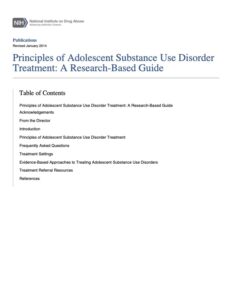 Since its first edition in 1999, NIDA’s Principles of Drug Addiction Treatment has been a widely used resource for health care providers, families, and others needing information on addiction and treatment for people of all ages. But recent research has greatly advanced our understanding of the particular treatment needs of adolescents, which are often different from those of adults. I thus am very pleased to present this new guide, Principles of Adolescent Substance Use Disorder Treatment, focused exclusively on the unique realities of adolescent substance use—which includes abuse of illicit and prescription drugs, alcohol, and tobacco—and the special treatment needs for people aged 12 to 17.
Since its first edition in 1999, NIDA’s Principles of Drug Addiction Treatment has been a widely used resource for health care providers, families, and others needing information on addiction and treatment for people of all ages. But recent research has greatly advanced our understanding of the particular treatment needs of adolescents, which are often different from those of adults. I thus am very pleased to present this new guide, Principles of Adolescent Substance Use Disorder Treatment, focused exclusively on the unique realities of adolescent substance use—which includes abuse of illicit and prescription drugs, alcohol, and tobacco—and the special treatment needs for people aged 12 to 17.
The adolescent years are a key window for both substance use and the development of substance use disorders. Brain systems governing emotion and reward-seeking are fully developed by this time, but circuits governing judgment and self-inhibition are still maturing, causing teenagers to act on impulse, seek new sensations, and be easily swayed by their peers—all of which may draw them to take risks such as trying drugs of abuse. What is more, because critical neural circuits are still actively forming, teens’ brains are particularly susceptible to being modified by those substances in a lasting way—making the development of a substance use disorder much more likely.


